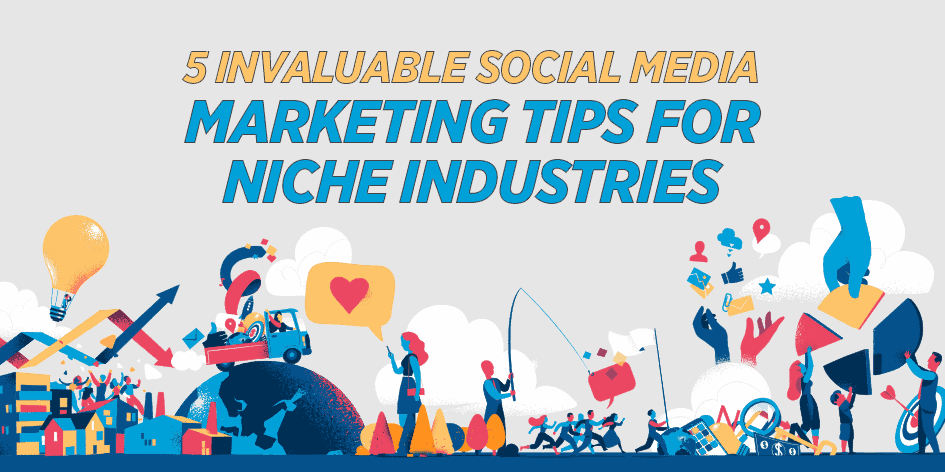Establishing a strong social media presence can be a challenge for businesses in niche industries.
When you’re just starting, you may have no idea how to begin getting followers on social media. What will they want to see from you? Will the customers you already have even care if you’re on Facebook? What kind of pictures could you possibly post on Instagram?
We’ve heard all these questions, and more, from our niche clients (many of whom happen to be B2B), and it’s true – it takes a lot more thought to create a solid Facebook post for, say, a B2B software sales firm than it does a B2C fashion retailer.
But that is not to say it can’t be done. In fact, niche industries can thrive on social media, just like more mainstream ones. All it takes is a little strategy.
To help you on your way, here are 5 invaluable social media marketing tips for niche industries.
Give your brand a face
One issue many niche businesses have is that they don’t come across as personal.
Although these are hardly niche companies, think of Microsoft or Apple without Bill Gates or Steve Jobs. Those high-profile individuals served as the faces of their massive companies, lending both businesses a radically higher appeal than they could have gotten simply as tech companies.
You certainly don’t have to have someone as big as Gates or Jobs at the helm to reap the benefits of personalizing your company.
Choose your founder, CEO, CMO, COO, or another high-level person who’s willing to take on the role. If they’re already on social media for personal branding reasons, this can be an easy transition.
All they have to do is make sure that information about the business is in their social media profiles, and that they frequently share posts from the company’s social media accounts with their own followers.
If you’re a smaller niche business, it’s perfectly feasible to start small. You could begin by using the photo and name of a real person at your business for each of your blog posts, or have the person in charge of the company Instagram account include a few co-workers in your posts on a regular basis.
The goal is to get beyond the image of the “faceless corporation.” The best way to do that simply depends on your business.
Put a name and face to your niche business’s social media profiles to drive engagement. #socialmediamarketing Share on XPrioritize thought leadership, and share widely
What is it that sets your company apart from the other companies that are doing the same, or similar, things as you?
Maybe it’s a particular value you bring to your customers. Perhaps it’s a unique take on your industry. Whatever it may be, one highly effective method of sharing that thing with current and potential customers is thought leadership.
This goes hand-in-hand with personalizing your company. You want others in your industry to look to you for informed opinions on new trends, on strategy, and on other important topics that influence your business and others like it.
You can do this by producing your own content, like white papers, blog posts, and explainer videos, and sharing them widely on your own social media profiles.
Another great way to get your message out is to put time into influencer marketing.
(Related content: Influencer Marketing from A to Z: a Complete Guide for Businesses)
Seek out other influencers and thought leaders in your space, and build those relationships. Comment on their content, engage with them on social media, and share their posts with your own audience.
Once you’ve established a relationship, you may be able to guest blog on an influencer’s site or partner with another industry leader for a webinar or virtual roundtable.
Being a thoughtful, yet frequent commentator on important industry issues will reflect highly on you, and by extension, on your business.
Being a thoughtful, yet frequent commentator on important industry issues will reflect highly on you and your business. Share on XMake sure your online and offline marketing are working together
Many niche industries rely heavily on offline marketing strategies, as well as online ones. Trade shows, conferences, product demos, training sessions – if you’re engaging in any of these for marketing purposes, you want to make sure that your online marketing is supporting these efforts, and vice versa.
The quickest and easiest way to bring these two worlds together? Live tweeting. If you’re at a keynote address during a conference, share salient thoughts from the speaker via Twitter, as they happen (being sure to give proper credit to the speaker, naturally).
In order to successfully live-tweet, you do need some preparation. You’ve got to know the speaker’s Twitter handle, for one, and if there’s a hashtag that the conference or speaker is using (and there almost certainly is), you need to know that, too.
For a full guide to how to live-tweet an event, check out our friends at HootSuite’s blog post “5 Things You Need to Know to Successfully Live-Tweet an Event.”
Live tweeting isn’t the only way to link up your online and offline marketing activities, however. Include a branded hashtag on your event signage, and ask customers to post selfies using the hashtag. You could advertise a promotion via your social media channels that can only be redeemed in person, at one of your offline locations or events.
Use analytics, as well as manual research, to ensure you’re giving your best customers the content they want
Creating and sharing content without a documented strategy behind it is like throwing a handful of darts at a dartboard – if you get a bull’s eye, it’ll be from sheer luck.
The same is true of your content marketing. If you’re creating and curating content without knowing for sure that it’s working, then you’re wasting resources.
This is especially true for niche industries, which often have a narrower group of topics to choose from.
So how do you get that bull’s eye on purpose, instead of by chance? Analytics.
Make a habit of checking your social media analytics regularly to see what’s performing well, and what’s failing. Do opinion posts from your CEO get shared more than posts on industry trends? Are your video case studies getting more views than your video testimonials?
Use the analytics to take your audience’s pulse, and when you see what’s working, make more of it.
If you’ve got star customers who are also active on social media, it can’t hurt to follow them and see what they’re saying and sharing about your brand (essentially this is a micro form of social listening). You’ll gain a better idea of what they like about you, what keeps them coming back, and what they think of your content. Those insights can help inform your content strategy going forward.
Use social media to improve your customer service – which will, in turn, boost your social media marketing
Social media is an immediate, effective way to address certain customer service issues – at the very least, it’s a way to acknowledge customer complaints or comments right away and direct them to the channels that will allow you to help them.
One of the reasons that social media has such potential for improving your company’s image (or if used poorly, hurting it) is, of course, that it’s public. If a customer posts a question on your Facebook page, and it’s answered quickly and courteously, your other Facebook followers will see that – and it will likely boost their positive image of you.
Given the public nature of social media, however, it’s also vital that you use careful judgment as far as when you should be directing customers to more private channels like email, phone, or your website’s customer service forms.
If you direct every question to a private channel, you can create the impression that you have something to hide. But if you try to manage an escalating conversation out in the open, you could end up with a PR nightmare on your hands.
In general, angry or unsatisfied customers are best served with a quick, but a sincere apology and a request to talk via another, private channel.
On the positive side of things, if you have customers who come out of their service issue feeling very happy with the result, it’s a nice touch to thank them publicly on your social media channels. Don’t share any details of the issue, but something like “Thanks for letting us help with your issue!” can be a gentle way of acknowledging the interaction.
Niche businesses don’t have to hide behind vague Twitter posts or an endless stream of shared blog posts when it comes to social media. For more on niche marketing, read our post “5 Awesome Digital Marketing Strategies for Niche Businesses.”





